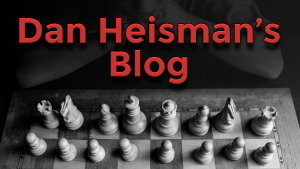Q&A with Coach Heisman July 25, 2014
"I noticed that the pre-registration for the Open section of the Holly Heisman Memorial (HHM) fundraiser chess tournament on Aug 3 (in Wynnewood, PA just outside Philadelphia) has several titled players. I am only in the 1500's. Is there any way I can play and not lose all my games?"
I get this misconception all the time. Modern players are used to playing in the U1800/U1600/U1400... big events with players near their rating. But when I started that was unheard of; most events were one "open" section with the best players playing in the same section as the beginners. In that latter case you had to beat the lower rated players for the right to play the higher rated; the swiss system at work.
So let's address the question. This requires us to speculate on the typical makeup of the section, and understand how swiss pairings work. In a normal swiss pairing, the top half of a score group gets paired with the bottom half, e.g., assume there were 8 players with a 2-0 score then, colors permitting, #1 plays #5, 2-6,3-7, and 4-8 (unlike, say tennis seedings where often it is 1-8,2-7,3-6, and 4-5).
The HHM has three sections:
- Open
- Under 1500
- K-8 U900
For the Open, let's assume the ratings go from 2300 down to 1500 and you are 1530. The median player is usually about 1900.
Suppose you get paired with a 1900 in the first round. That's not terrible - he's 100 points shy of the expert title and, even with a 400 point rating difference, the USCF rating system estimates you should win about 11% of the points from him in the long run.
So even though you should not enter the game thinking a loss is inevitable (please read The Self-Fulfilling Prophecy!), suppose you do lose. Then we will assume most of the other boards go according to form, and almost all the top players win. That means the 0-1 pairing group for HHM is pretty much players rated 1500-1900. So if you are near the bottom you get paired with a player probably in the 1700s, so the matchup would be 1530-1730, where you would be expected to get 24% of the points in the long run.
OK, so bad day, you lose again. But now the 0-2 score group is mostly 1500s and 1600s so let's say you get a 1630, with a 36% point expectancy. That's now a total of 11+24+36 = 71 total, or 0.71 points. In other words, you should expect at least a draw from this set of pairings. But, woe is you, you lose again. But now, far from playing a titled player, you are probably going to be paired with someone with a rating like yours or even possibly someone less than 1500 who is playing "up" in your section. And even if you win, your final round opponent should not be really high - let's say 1700.
So if you are having a bad day, your opponent list could look something like: 1900-1700-1600-1500-1700. That's hardly a killer's row of titled experts (2000-2199) and masters (2200-2399) no matter how many are in your section.
But the good news is, suppose you win an extra game or two. Suppose somehow you find yourself with a 2-1 record and get paired with a 2060? That's the good stuff! Then you are deserving of a strong opponent.
Remember, the first time I was ever paired with a master (also in that same The Self-Fulfilling Prophecy), I was rated in the 1600's and won! Six months later I was paired with the same player, I was black, and he was looking for revenge; I won again. Don't fall for the self-fulfilling prophecy. Always play with confidence, aggression, and respect for your opponent's moves and ideas.
---------------------------------
"What if I like chess but I don't like to compete?"
You are not alone! Chess is a great game with many facets, and you can really enjoy the game and many of its facets without really getting into the competitive side. Many lifelong devotees start out as players, fall in love with the game, but then decide that the competitive side is a little to intense (or whatever) for them. But the chess world is a big place and there is room for many different roles; besides player there are, to name a few:
- Tournament Director (we need as many as possible!)
- Tournament Organizer (even more rare and needed!)
- Journalist (online, state magazine, national magazines, etc)
- Problemist (there are many types such as compositions)
- Author (but you probably at least have to be a decent player)
- Collector (books, memorabilia, autographs, chess sets!)
- Chess.com Group Administrator, etc.
I am sure you get the idea. I have not played serious rated chess in almost a quarter century (ouch!), but at one point I counted myself as having 14 different hats. I think I am down to about 9. 
---------------------------------------------------
The subject of retrograde analysis came up. I think the most famous problem was created by Raymond Smullyan and was on the cover of his second retrograde book (Ignore the white king in the following diagram; it is not there):
White's king has been knocked off the board. Who made the last move, and what was it? (again, pretend there is no white king on the board; I don't think the Chess.com diagram maker will allow me to make a diagram without it, so I placed one on a2 but it should not be there).In this position you know the lower right hand square is white, but you are not told whether it is h1 or a8. But at least you know White and Black are sitting at the top and bottom, not the sides. If the lower right hand square were black, then the board would be sideways, and the previous move could have been 1.d7-d8B+, but that's not possible here. So how could this position (sans white king), have legally occurred?
Answer next show Aug 8! 



